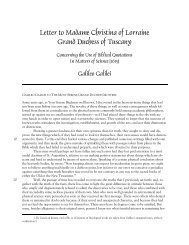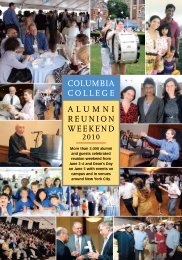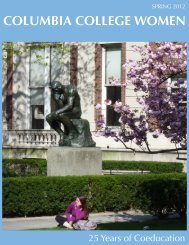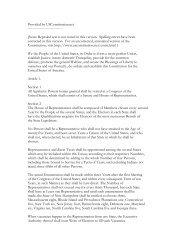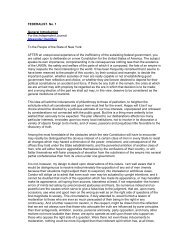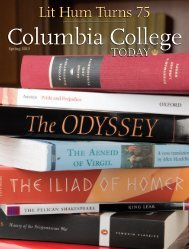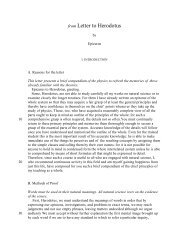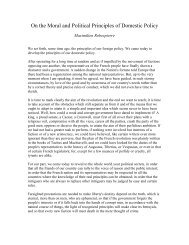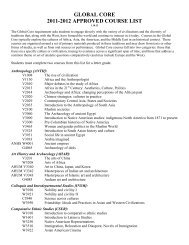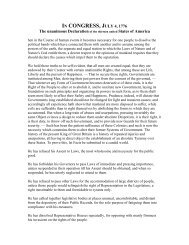Japan Storm - Columbia College - Columbia University
Japan Storm - Columbia College - Columbia University
Japan Storm - Columbia College - Columbia University
Create successful ePaper yourself
Turn your PDF publications into a flip-book with our unique Google optimized e-Paper software.
COLUMBIA COLLEGE TODAY JAPAN AFTER THE STORM<br />
swore he would never go to <strong>Japan</strong>,” he says. “And I wind up<br />
spending a good chunk of my career tied to <strong>Japan</strong>. What if I hadn’t<br />
read Landscapes and Portraits?”<br />
Keene’s approach to teaching and writing bears the imprint<br />
of his freshman Humanities instructor, Mark Van Doren<br />
’21 GSAS. “He was a scholar and poet and above all someone<br />
who understood literature and could make us understand it<br />
with him,” Keene writes in Chronicles of My Life: An American in<br />
the Heart of <strong>Japan</strong>. “Van Doren had little use for commentaries or<br />
specialized literary criticism. Rather, the essential thing, he taught<br />
us, was to read the texts, think about them, and discover for ourselves<br />
why they were ranked as classics.”<br />
The experience of taking the <strong>College</strong>’s general education courses<br />
was “incredible,” Keene says, and he fondly remembers the<br />
great teachers he encountered as an undergraduate. Among them<br />
were the “learned and gentle” classicist, Moses Hadas ’30 GSAS;<br />
Lionel Trilling ’25, ’38 GSAS and Jacques Barzun ’27, ’32 GSAS,<br />
who led Keene’s Senior Colloquium; and Pierre Clamens, a French<br />
instructor “who was very stern, but gave everything to his students,”<br />
Keene says.<br />
His chief mentor, however, was cultural<br />
historian Ryusaku Tsunoda, a pioneer<br />
of <strong>Japan</strong>ese studies at <strong>Columbia</strong><br />
whom Keene often refers to, simply, as<br />
Sensei. “He was a man I admired completely,”<br />
Keene says, “a man who had<br />
more influence on me than anyone else<br />
I can think of.”<br />
As a senior, Keene enrolled in Tsunoda’s<br />
course in the history of <strong>Japan</strong>ese<br />
thought. Fifty years later, in a CCT<br />
interview (Winter 1991) with David<br />
Lehman ’70, ’78 GSAS, Keene remembered:<br />
“The first class, it turned out I<br />
was the only student — in 1941 there<br />
was not much pro-<strong>Japan</strong>ese feeling.<br />
I said, ‘Wouldn’t it be a waste of your<br />
time to give a class for one student?’ He<br />
said, ‘One is enough.’”<br />
Keene accepts flowers upon arriving in <strong>Japan</strong> on<br />
September 1.<br />
Born in 1922, Keene speaks with<br />
some sadness of his boyhood in<br />
Brooklyn’s Flatbush section. In 1934, he lost his sister, which<br />
left him an only child. Keene’s father, who sold radio parts and<br />
later real estate, left his mother “under very unpleasant conditions”<br />
when he was 15, Keene says. “And then he disappeared<br />
from my life altogether for a period. I didn’t even know where he<br />
was.” Keene himself has never married.<br />
Lonely and, by his own reckoning, exceptionally unathletic,<br />
Keene found solace in stamp collecting, which open ed his eyes<br />
to a wider world of nations and languages, and in movies, which<br />
opened his eyes even wider. Years later, as a professor, Keene escorted<br />
Greta Garbo, a friend of a friend, to the Broadway production<br />
of The Diary of Anne Frank. “After emerging from the theater,<br />
we waited briefly for a taxi, and the drivers of passing cars halted<br />
their vehicles for a better look at the famous face,” he later recalled.<br />
In 1938, Keene attended his first performance of the Metropolitan<br />
Opera; it was Orfeo ed Euridice. The following year, as a<br />
birthday gift, his mother gave him a subscription to 16 successive<br />
Friday nights at the Met. The teenaged Keene sat in the last row<br />
of the uppermost tier, where tickets cost $1, and was hooked for<br />
PHOTO: THE YOMIURI SHIMBUN VIA AP IMAGES<br />
WINTER 2011–12<br />
31<br />
life. One of Keene’s chief regrets in leaving New York is giving up<br />
his Met Opera subscription.<br />
It was also in 1938 that he graduated from James Madison High<br />
School, a Brooklyn public school that also has produced four Nobel<br />
laureates, three U.S. senators and a Supreme Court justice — Ruth<br />
Bader Ginsburg ’59L (not to mention Judge Judy, songwriter Carole<br />
King and comedian Chris Rock). Thanks to a Pulitzer scholarship,<br />
Keene was able to attend <strong>Columbia</strong>.<br />
Apart from his studies, college proved to be rough going<br />
for the commuter student. “I had no campus life,” Keene<br />
says. “Other people were living in the dormitories or near<br />
the <strong>University</strong>. But my mother was pretty hysterical at that time;<br />
she depended on me, and I had to make the long journey every<br />
day. The subway cars were badly lit and I ruined my eyes. I knew<br />
very few people, had almost no friends.”<br />
His closest acquaintance was a Chinese student named Lee who<br />
happened to have been seated behind him in Van Doren’s class.<br />
The following summer, in 1939, they took to swimming together at<br />
the Riis Park beach in Rockaway, Queens. Lee taught Keene some<br />
Chinese characters, which he practiced<br />
drawing in the sand. It was his introduction<br />
to Asian languages. For the next two<br />
years, they ate lunch together every day<br />
at the New Asia restaurant at Broadway<br />
and West 111th Street, which became<br />
Moon Palace.<br />
One day in fall 1940, Keene was<br />
browsing the remainder shelves at a<br />
Times Square bookseller when he spotted<br />
a two-volume edition of the classic<br />
work The Tale of Genji, selling for just 49<br />
cents. He bought it and was so enchanted<br />
by the story, and by Arthur Waley’s<br />
elegant translation, that he yearned to<br />
read it in the original <strong>Japan</strong>ese.<br />
At a time when news of mounting<br />
violence overseas dominated the headlines,<br />
the tale offered a more peaceful vi-<br />
sion. “The hero, Genji, unlike the heroes<br />
of European epics, was not described<br />
as a man of muscle . . . or as a warrior<br />
who could single-handedly slay masses<br />
of the enemy,” Keene wrote. “He knew grief, not because he had<br />
failed to seize the government, but because he was a human being<br />
and life in this world is inevitably sad.” Keene says today:<br />
“The book became, literally, my salvation from the newspapers,<br />
from the horrible things that were going on in the world.”<br />
Chance continued to play a part in Keene’s turn to the Orient,<br />
as it was then commonly called. In spring 1941, a stranger approached<br />
him in the East Asian Library, housed in what is now<br />
the Faculty Room in Low Library. He introduced himself as Jack<br />
Kerr, and mentioned seeing Keene often at the Chinese restaurant.<br />
Kerr was forming a small group to study <strong>Japan</strong>ese that summer<br />
at his house in the North Carolina mountains, and wondered<br />
if Keene might care to join them. Keene accepted. It was Kerr —<br />
who went on to teach <strong>Japan</strong>ese history at other universities —<br />
who recommended that Keene register for Tsunoda’s class for the<br />
Fall 1941 term.<br />
On December 7, 1941, Keene went hiking on Staten Island.<br />
When he returned to lower Manhattan, he saw the news: The<br />
<strong>Japan</strong>ese had attacked Pearl Harbor. Tsunoda was detained the




